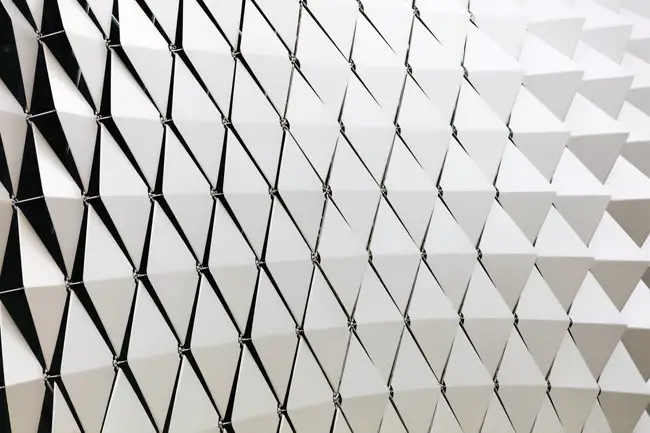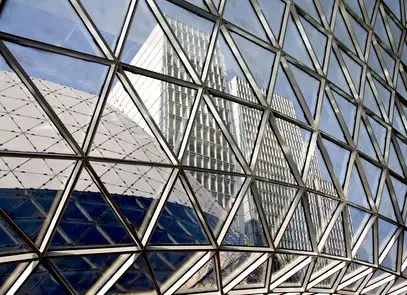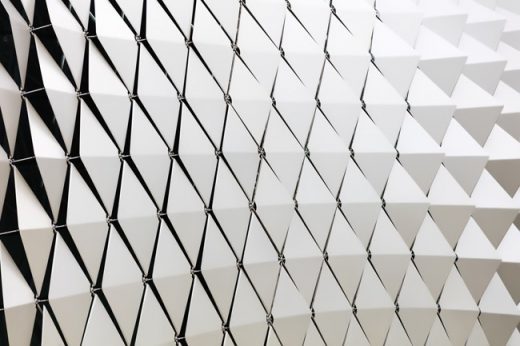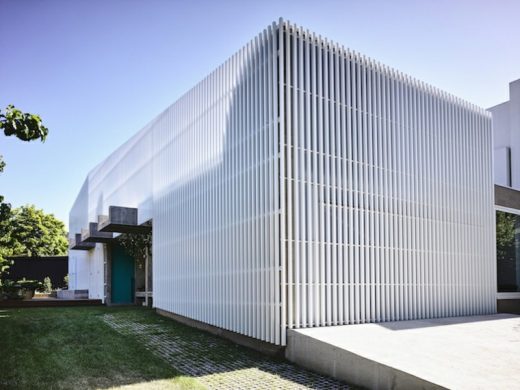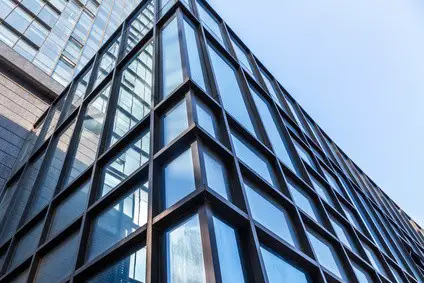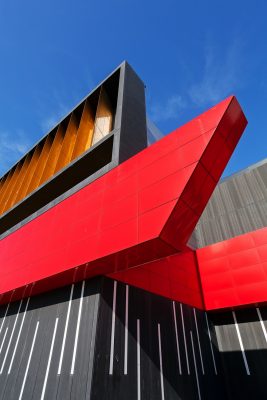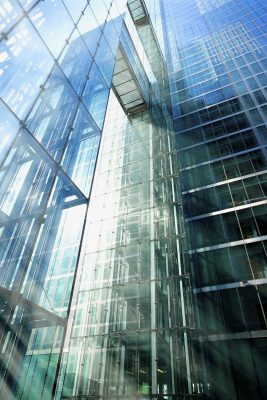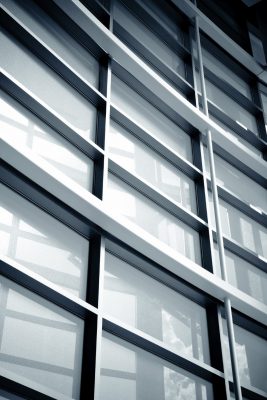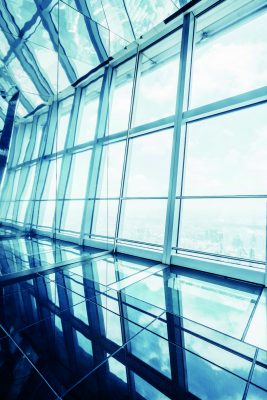New CTE Technical Building Code, AEA Spanish Aluminum Association, Spain Architecture
New Technical Building Code (CTE), Spain
28 Apr 2020
New CTE Technical Building Code
The AEA outlines the role of aluminum in the framework of the new Technical Building Code.
News release from the Spanish Association of Aluminum and Surface Treatments – Asociación Española del Aluminio y Tratamientos de Superficie (AEA).
• Aluminum facilitates the adaptation of the construction sector to the economic, energy and environmental sustainability strategy set out in the new CTE.
• Aluminum contributes to creating energy efficient buildings, comfortable, with the least possible environmental impact, and whose components can be recycled or reused.
• Associations such as AEA and ASEFAVE have helped companies in the sector to prepare for this new scenario.
Madrid, Spain, April 28th 2020 – Today, around 47% of the energy produced worldwide is consumed by buildings and constructions. A fact that gives us a clue about why it was necessary to incorporate new requirements into the Technical Building Code (CTE), in a search to alleviate the problem of energy consumption in line with European legislation and challenges.
From the AEA – the Spanish Aluminum Association, which represents more than 600 companies in the sector – welcome the incorporation of these new requirements and analyze how this new document affects or may affect aluminum as a material to opt for from the construction sector.
The new CTE was approved in December 2019. Its compliance will be mandatory for all those new constructions that start from the end of September 2020. Regarding the deadlines for voluntary application, the coronavirus crisis has led to the addition of the date for the final calculation. The original end date (June 27, 2020) will be extended in calendar days, corresponding to the duration of the alarm state.
There are three fundamental aspects that have been affected by this new Technical Code and the changes it incorporates. Broadly speaking, it is about energy saving, the basic health requirements of buildings, and fire safety in them. Among them, we must put the focus on the first point, since the updated in this sense affects closings and, in general, any architectural system or aluminum facades, so that it will have to contribute to meeting the minimum requirements required for new constructions.
Inés Gómez Arroyo, head of the Technical Department of ASEFAVE, explains that “the modification of the CTE fundamentally affects the Basic Document for Energy Saving (DB-HE), which affects habitability. Something that has been motivated by the transposition of the European Directive on Energy Efficiency of buildings 2010/31 / EU, essential for reducing greenhouse gas emissions and save energy ”. Something that each of the Member States will have to incorporate into their legal systems.
Aluminum, a sector up-to-date in the demands of the new CTE
Inés Gómez Arroyo affirms that “from a technological point of view, the aluminum sector already has solutions to comply with the current CTE (not only windows, also facades and sun protection elements). Perhaps the most important challenge is that the Code has evolved from setting mandatory values for the different elements of the building envelope, to justifying compliance through global building indicators”.
Jon de Olabarria, Secretary General of the AEA, points out that “in this way, it is a collaborative exercise and work, a global contribution of all the elements that make up the new building projects, and from the aluminum sector we have invested all the efforts and possible progress so that our contribution is as optimal, supportive and reciprocal as possible”.
The Secretary General of the AEA says that “that of aluminum is a sector that arrives with the duties done to the demands imposed by this new CTE. We have been attentive since the first sketches that have appeared to take into consideration each of the novelties that were being traced and understand that, from now on, each constructive element must contribute together with the rest to meet the new required objectives”.
Gómez Arroyo indicates that “aluminum systems will have to be considered from the beginning of project conception. With this new CTE, an adequate design of the building and its gaps will be essential, taking into account from the initial phase the orientation of the building, its compactness, the proportion of gaps it has and the solar protections that it is necessary to install to to be able to reach the low energy demand values of this new CTE.
The modeling and definition of a suitable thermal envelope will be a fundamental phase to be developed by the prescribers with the help of the manufacturers of the carpentry systems. A good design of the enclosure will be basic to meet the requirements of the Basic Document of Energy Saving”, something for which the aluminum cladding sector, both say, is ready.
The suitability of aluminum as a material in line with the demands of the new CTE
There are several aspects that each of the elements that make up the buildings of the future must meet. Regarding carpentry, explains Inés Gómez, “the Technical Building Code sets out the requirements that these have to meet not only from the thermal point of view, but from different aspects related to acoustic insulation, sanitation, wind resistance , etc., guaranteeing an adequate quality of the holes that are incorporated and with the benefits over time.
Thus, aluminum-based solutions must meet not only the thermal requirements, but also the rest of the CTE requirements, guaranteeing the useful life of buildings over time. In this sense, aluminum stands out for its versatility; The applications in which it is located in the building envelope are diverse. Furthermore, from an environmental point of view, its high recyclability further favors its use”.
Walkie Talkie Building London facade:
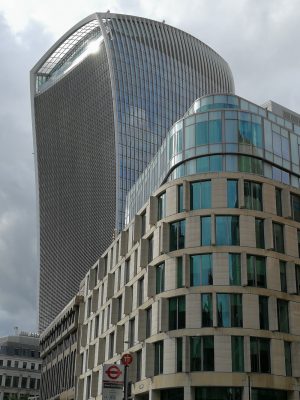
Aluminum stands out for its durability, its insulating capacity, the low need for maintenance, its versatility and malleability, but also its hardness and resistance, which favor the safety of spaces. And not only that; Also, we must highlight that aluminum is a totally and infinitely recyclable material, without diminishing its qualities.
Furthermore, for the recycling process it requires only 5% of the energy that was necessary to produce primary aluminum. At this point, we must remember that sectors such as construction and automotive already recycle more than 90% of aluminum.
All in all, says Olabarria, “aluminum helps to ensure the existence of safer, more livable, more durable, higher quality and more sustainable buildings. Aluminum facilitates the adaptation of the construction sector to the strategy of economic, energy and environmental sustainability set forth in this regulation, making it ideal on the path towards the implementation of a Circular Economy model”.
Inés Gómez points out that “the normative evolution, and not only of the CTE, tends to solutions at the building level, the material is not so decisive, but its contribution to global indicators of the building”. In this sense, he puts Olabarria as an example, “aluminum windows more than comply with the most restrictive U values, guaranteeing interior comfort and energy saving and contributing with their action to achieve the global objectives of all the components”. In short, he maintains, “aluminum is closely linked and committed to this CTE, since this material widely meets all the requirements set forth in this regulation as part of the building envelope”.
“Not everything ends with the CTE”, says the head of the Technical Department of ASEFAVE; “The tendency is to create buildings that are not only energy efficient but also comfortable, with the least possible environmental impact and that generate the least amount of waste, valuing their recyclability or reuse. With these criteria, aluminum ensures a long life in the building sector”.
Sector action, essential in preparing for the new scenario
Gómez Arroyo explains that “the initial draft amendment to the Technical Code was published in June 2018, and since that time until the date of definiteive publication on December 20, a period has passed in which it has been attempted by the sector associations to give to know the fundamental lines of modification of this Technical Code with the new indicators related to energy consumption, and to the control of the energy demand of the building, in which the gaps in the building play a fundamental role”.
Jon de Olabarria points out that “the objective has been to help companies in the sector to be prepared for the modification of this Technical Code, a work to which we have contributed associations such as the AEA or ASEFAVE, which has contributed as part of the Committee in different congresses. Technician to reflect on the modifications of the CTE and on the future and the challenges that it represented”.
Inés Gómez warns that “accustomed to working from memory with specific values, each day it will be more necessary for companies to advise their clients on the ideal solution for their project, since each building needs a specific study. For this, the existence of a powerful technical office in the organization chart is necessary. It is a job and some positive modifications that seek greater comfort and quality of life for users of homes and buildings, with an impact on their health”.
And he concludes by noting that “it is noteworthy that on the energy issue there is still progress to be made to achieve the strategic framework for the year 2050 of decarbonisation of the economy and especially of the building sector. To achieve these objectives, it will be necessary to address aspects related to sustainability, the circular economy, the durability of materials and maintenance of benefits over time, the energy embedded in the materials, recycling, reuse or reuse of the materials, among others”. “Something in which – in the words of Jon de Olabarria – aluminum has and will have a lot to say”.
The Spanish Association of Aluminum and Surface Treatments (Asociación Española del Aluminio y Tratamientos de Superficie – ‘AEA’). The AEA is a non-profit association that performs the adequate representation of the Spanish aluminum industry -from extrusion companies, to surface treatments and distribution- and that watches over the defense of its global interests. The Association represents some 650 companies that directly employ more than 8,000 workers.
The AEA works to make clear the commitment of this industry to quality, promoting the establishment in Spain of the most demanding European quality brands, knowledge in our country of the advantages of using aluminum products and sustainable industrial development. in its different aspects: environmental, economic and social.
For this reason, the AEA represents and manages various Quality Marks and Seals related to surface treatment as General Licensee for Spain of the international Quality Marks QUALANOD, QUALICOAT, QUALIDECO and QUALISTEELCOAT and provides its partners with the tasks of supervision and management of all aspects related to them.
Likewise, the Association participates in several AENOR Committees related to standardization and certification in Spain; It is part of CONFEMETAL, ATESMEL and the Green Building Council Spain and, internationally, is a member of the European Association for Surface Treatment on Aluminum (ESTAL).
AEA – Asociación Española del Aluminio y Tratamientos de Superficie
Teléfono: (+34) 914 112 791
Web: www.asoc-aluminio.es
[email protected]
Location: Madrid, Spain
Architecture in Madrid
Madrid Architecture Design – chronological list
Castellana 77, AZCA district
Architects: luis vidal +arquitectos
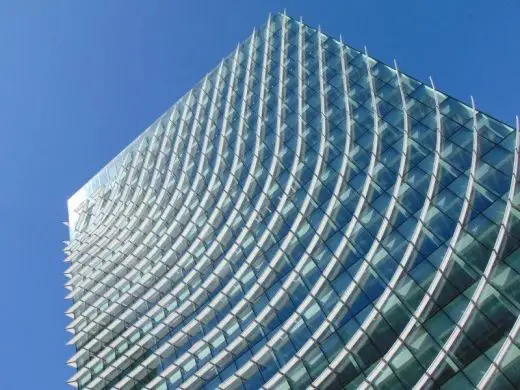
photo © luis vidal + arquitectos. All rights reserved
Castellana 77 Building
Museo del Prado Madrid Design
Design: Gluckman Tang Architects – Estudio Álvarez Sala – Arquitectura Enguita y Lasso de la Vega
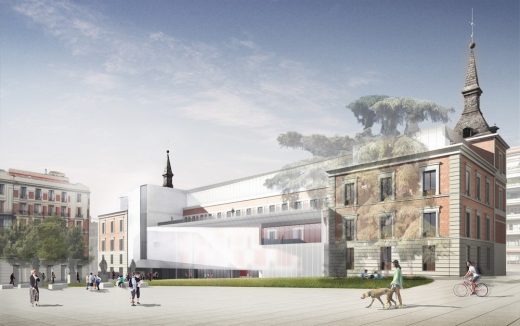
image Courtesy Gluckman Tang Architects
Museo del Prado Building Design by Gluckman Tang Architects
Architecture Tours Madrid by e-architect
Comments / photos for the New Technical Building Code – CTE Architecture page welcome

